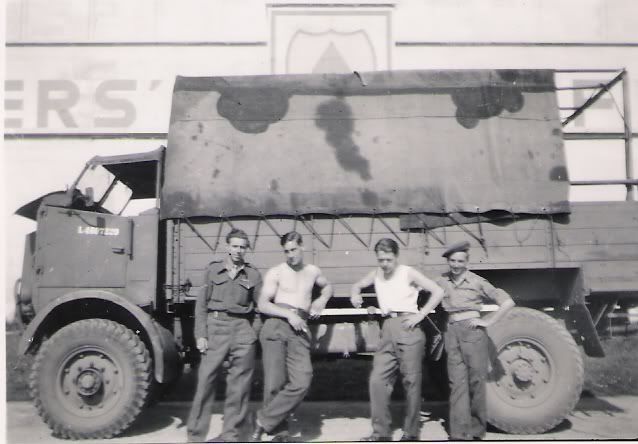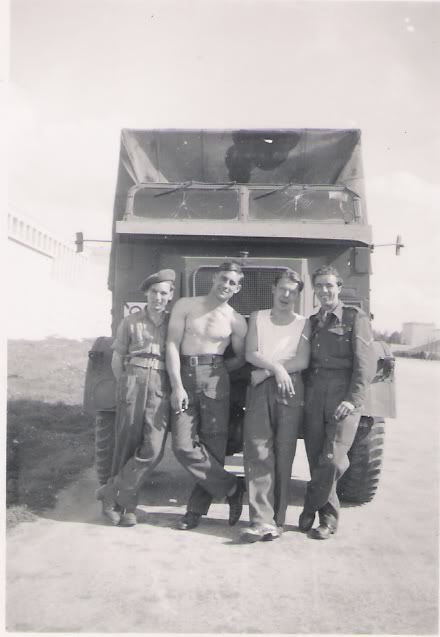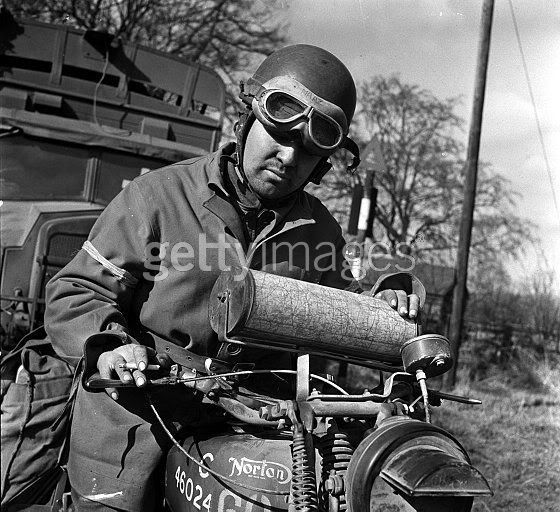-
Posts
1,024 -
Joined
-
Last visited
-
Days Won
6
Content Type
Profiles
Forums
Gallery
Blogs
Events
Articles
Store
Downloads
Posts posted by 79x100
-
-
Good Point. I reckon the implication there with the NA suffix is probably that all TRWs or major components were made in 1952 (with a view to large Korean war sales ?) but actually delivered over the next ten years or so.
The records at the VMCC should be able to confirm actual delivery date.
-
Hello Maggie,
This site suggests a 1952 date.
http://www.tri-corengland.com/acatalog/Triumph_Dating_information.html
Your first step should be to contact Annice at the Vintage Motorcycle Club Library. They have the factory despatch records and should be able to tell you where it was originally sent. Wartime supplied vehicles can be confusing because the Canadians did receive some via British channels but post-war machines would have been ordered direct.
http://www.vmcc.net/library.htm
If your bike does turn out to be ex-Canada then Richard's suggestion of looking at 'Maple Leaf Up' is a good one as they will be able to advise on Canada specific markings if you intend to follow that route. They looked fine straight from the factory as well, of course !
Keep us posted !
-
Well, it's taxed.
VEHICLE ENQUIRY Services Provided By DVLA: DVLA
The enquiry is complete
The vehicle details for 523 XUG are:
Date of Liability 01 09 2009
Date of First Registration 04 09 2007
Year of Manufacture 1954
Cylinder Capacity (cc) 0CC
CO2 Emissions 0g/Km
Fuel Type Petrol
Export Marker Not Applicable
Vehicle Status Licence Not Due
Vehicle Colour BLUE
Vehicle Type Approval null
The information contained on this page is correct at the time of enquiry.
Very bad news indeed and will exactly pander to those who don't understand.
At least it wasn't tracked. Can you imagine Met Police armed response teams having to be trained to use the Boys rifle ? I'd like to see a film of them learning to cock the PIAT !
-
A couple of my dad's photos taken just post war in Nuremburg. A K5 portee to GS conversion.


Sorry that his mates stood in the way !
-
Hanno, it was of course developed from the original Dutch GSP (Geplooide Straten Plan)
-
Here's one with a wireless house body from Getty Images. Partially hidden by some old motorbike with the strangest unofficial map holder I've ever seen.

-
I don't think it would be a bad thing if the 'British' section were to be amended to 'British and Commonwealth' Always nice to see RHD trucks !
-
I sometimes have the impression that the 'military' aspect is used as an excuse for bad workmanship and lack of attention to detail. Another layer of greenish paint will cover a multitude of sins.
With regard to WW2 British vehicles, it is evident from period literature and photographs that away from the front line and even before the formation of REME and the Task System, there were rigid maintenance schedules and vehicles were kept clean.
I have been trying to maintain the originality of my ex-BEF Norton whilst trying to achieve a workmanlike impression of it in service. It isn't easy. I've been able to resist the temptation to knock the dings out of the mudguards and I've avoided cleaning up small areas of damage but if durability is required then the refinishing has to be more than a layer of paint on top of everything.
I very carefully hand cleaned the ali castings to avoid a newly blasted look only to find that the Norton records show that a shot blast finish was used to dull down the bright new castings.
That almost all BEF motorcycles had bent mudguards and dented tanks is evident from pictures of how they were netted ashore at Cherbourg.
Most Nortons in service have characteristic vertical dents on the fuel tank where the forks make contact in a tumble.
...Damn How I wanted to fill those dents. I've managed to leave them though but it took me a while to be certain about it.
-
Tailgunner, your best option is to look for a worse-paid job. That way you'll minimise your theoretical losses !
-
You are very kind. However, we are just enjoying a completely pointless pastime in the best way we know!
Cheers!
Steve
A chap without a pastime is a pretty poor type of fellow indeed ! Such things are never pointless. Keep up the good work.
-
The same auctioneer as the Roudeix collection. Can't find anything on line about this sale.
-
There are some strange contradictions in the only area that I know anything about (British WD motorcycles). Pre-war and into 1941 or so, the specification tags on Lucas Magdynos and Smiths speedos were aluminium and the contract plates were brass.
Presumably to save aluminium on the first two, they changed to brass but the contract plates were altered from brass to steel !
-
Were Rubbolites black-out compliant ? They were certainly a pre-war fitting as Richard says and presumably needed adaptation once the black-out regs came into force ?
Rubbolites were fitted to India Office Contract Nortons from January 1937 onwards, whilst War Department machines retained the standard civilian pattern Lucas MT110 which was fitted with a small black manilla mask once hostilities broke out and was replaced by a new even smaller lamp known as the 'fag end' because that is about the glow it gave, from early 1941 onwards.
There is no doubt that from the fall of Singapore / loss of Malaya onwards, all efforts were made to save rubber for essential items.
-
One has to be registered on GWF in order to view the images. Somehow the rather elitest feel has always scared me off.
-
Crikey Richard, Do you know the photograph or did you recognise the village ? I can mail the whole article through to you if you like. There are a couple of M20s practising up on the downs as well.
-
-
Thanks Ivor, I should have thought of them. I was a member once (but in my pre-computer days). Their forum doesn't seem accessible to non-members. Would any EMLRA member be prepared to copy or link this thread onto their forum ?
-
No idea on the truck but I assume that the bike is a Megola ?
-
Can anyone tell me if there is a register of ex-military Land Rover survivors and if this one is still around ?
I have the full maintenance and servicing history for it. It would be nice if the paperwork could be re-united.
It doesn't seem to have been the most reliable of vehicles - new engines at 54729, 66749 and 89064 miles.
-
Thanks once again Ivor for some wonderful pictures. Pre-war bikes and Service Dress - Old photos don't get much better for me.
I think that RMT 540 is actually a 1939 C10 BSA. If the census number begins C3995, that would confirm things. Delivery of contract C.3939 (C399327 - C399926) commenced in May 1939. What rank did Callow hold in the photo ?
The Enfield is also a 250, a WD/D from contract C4452 (C3922045 - C3922944)
Both of these 250 sidevalvers were regarded more as light communications machines and were generally retained for home service.
I suspect that the 'other' desert Norton is a slightly later one from Contract C.7353 (C4386027 - C4403026) Machines up to about C4392000 still had those rather peculiar double steel toolboxes visible in the picture. I now know that they were 'Footrests, trick riding, officers for the use of' which also explains why most of them are so dented and twisted !
Rich.
-
Fascinating pictures Ivor. Always so much more interesting and useful when the unit can be identified.
Can you by any chance read the census number on the C.6653 contract Norton that the officer is seated on ? If it's any help, it would be between C4316278 and C4320277
The bike is a late 1940 produced machine and looks to be still wearing it's original Khaki Green finish. Do you know when that particular photo was taken ?
...and the inevitable question - Any more motorcycles ? I imagine that a Manx unit would have contained plenty of keen motorcyclists ?
-
Isn't 'cramp' just a more traditional (and correct ?) name for a clamp as in 'Sash cramps' ?
Googling 'Chain clamp' shows devices for clamping circular objects on a work table on the same principle as a chain wrench.
-
Don't forget that the locomotive chaps started with a fairly recent loco simply because it was an unrepresented class, not because it was the oldest. Might it not be a mistake to be too ambitious ?
I don't believe that there are any of those nice 'nose-high' early Carriers left. How about a Scout Carrier with a Boys rifle and a Bren on an AA pintle ?
I bet that Ford's engine plants would fight amongst themselves for the chance to build a flat head V-8 again !
-
Does the Douglas owner need a WD marked carbide lamp ?
eBay 110313719379



.thumb.jpg.8638c1c2349aab3213f0d167c381528f.jpg)



Paint question
in I may be stupid, but......
Posted
There are isocyanate-free 2-packs available and brush or roller finishing reduces the risk.
The nice thing about 2-pack is that it's pretty well fuel resistant and doesn't normally react with existing finishes.